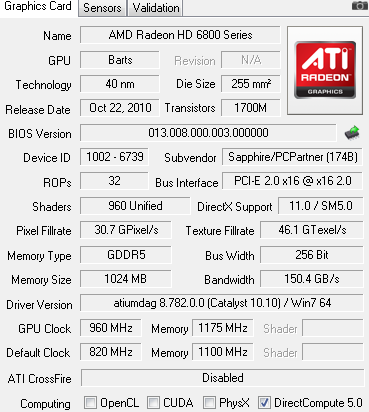Overclocking the trio
AMD's meagre 820MHz core-speed limit on partner-overclocked Radeon HD 6850 GPUs hampers the cards' ability to perform better in benchmarks. We're sure that, if given carte blanche, partners would specify higher frequencies.We overclock the trio in a pragmatic fashion. If the card is supplied with an overclocking utility - as Sapphire and ASUS are - the voltage is increased to 1.25V. It is left at stock on the PowerColor card, which does without any user-accessible voltage adjustment.
Keeping it simple and leaving the fans on automatic, here's what we got to after fighting with frequencies, lock-ups and stress-testing with FurMark and Call of Duty: Black Ops.
| Video card | AMD HD 6850 reference | Sapphire HD 6850 TOXIC | PowerColor HD 6850 PCS+ | ASUS HD 6850 DirectCu |
|---|---|---|---|---|
| Core clock | 775MHz | 820MHz | 820MHz | 790MHz |
| Memory clock | 4,000MHz | 4,400MHz | 4,400MHz | 4,000MHz |
| OC Core clock | 915MHz | 960MHz | 940MHz | 940MHz |
| OC Memory clock | 4,500MHz | 4,700MHz | 4,650MHz | 4,650MHz |
| Percentage improvement at 19x10 | 13.9 |
12.9 |
11.2 | 14.9 |
While Sapphire's cooler isn't the best in terms of noise and sheer performance, the underlying GPU, on our sample at least, is the most partial to frequency of the bunch, overclocking close to 1GHz on the core with a minor bump in voltage.
Running Just Cause 2 and Aliens vs. Predator at 1,920x1,080 and noting the improvement over shipping frequencies, the Sapphire card is the absolute fastest, but the ASUS card shows the best increase.










